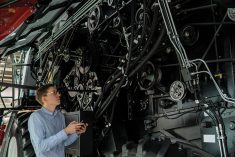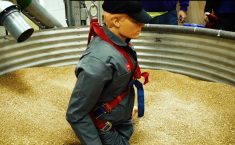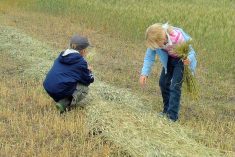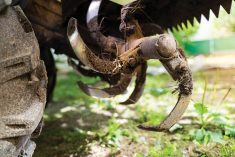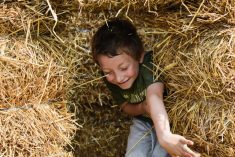This year, for Canadian Agricultural Safety Week, the Canadian Agricultural Safety Association is working towards “Keeping Kids Safe” as a part of the three-year theme of “Be An Ag Safe Family.” Part of keeping kids safe on the farm is creating, using, and maintaining a safe play area.
Play teaches children co-operation. Play helps children improve their balance and co-ordination, to strengthen their muscles. Play also challenges kids’ imaginations, and teaches children how to problem-solve and how to be part of a team. And play lets kids be kids. With a safe play area, children can experience the joys of play and reduce the risk of injury on the farm.
Read Also

Health hazards are often overlooked risks on the farm
While quite different from the dangers posed by farm machinery, hazards such as loud noise or sun exposure require the same proactive attention, the Canadian Agricultural Safety Association says.
Location matters. A safe play area should be designated by boundaries or physical barriers such as fences, gates or shrubs. It’s important that the play area is away from the majority of farm activity. Keep in mind traffic, livestock, farm machinery, open water and noise when deciding where the play area should be located. Make sure the location is free of hazardous plants like poison ivy and pests like wasps. Ensure that there is sufficient shade and is free of obstacles like power lines or unstable structures. Also, make sure the location of the play area is within sight and hearing distance of a responsible adult.
When selecting a location for the safe play area make sure to keep in mind how much space the children using it will need. A small area appropriate for a three-year-old, won’t be as useful for a faster, bigger 10-year-old.
Equipment matters too. A big factor in creating a safe play area is having equipment that kids want to use. Playground equipment, a club house, balls, balance beams, and swings are all great ideas to include in your safe play area. Make sure that they are hazard-free and secure. Protrusions like bolts can be hazardous while playing.
Maintaining and improving the play area is an on-going task. Develop a routine inspection and maintenance plan that includes keeping grass mowed, checking equipment for loose or broken parts, adding protective ground surfacing and reviewing safety rules. Make improvements as needed and modifications as children outgrow the existing play equipment.
There are no guarantees that any play area is truly safe. Children can be unpredictable and they don’t always make the safest choices. What we can do is to create, use and maintain a safe play area combined with careful, competent supervision can help greatly reduce the risk to children on the farm.
According to the National Children’s Center for Rural and Agricultural Health and Safety, there are six steps in developing a safe play area. Here they are for quick reference:
- Locate a site to be developed into a safe play area. The location should provide maximum play options with minimum exposure to agricultural hazards.
- Sketch out the ideal play area for that site, considering ways to promote fantasy, manipulative, swinging, climbing and riding activities. Plan for modifications in play activities as children grow.
- Determine materials needed. Make, buy or adapt for different play activities. Refer to playground equipment Web sites or other resources for specific guidance related to residential play areas.
- Build the play area including appropriate ground surfacing, borders, fences and gates. Older children can assist with this process if they are supervised.
- Use the play area. Explain safety rules and post signs if needed. Observe young children, older siblings and adult supervisors as they enjoy the area. Think about immediate modifications and future changes based on how the area gets used.
- Maintain and improve the safe play area. Develop a routine maintenance plan that includes keeping grass mowed, checking equipment for loose or broken parts, and reviewing safety rules for visitors. Let older children help with inspection and maintenance because this enhances their ownership and reinforces the importance of telling adults about possible hazards. Make improvements as needed and modifications as children outgrow play
For more information about safe play areas and keeping kids safe, visit agsafetyweek.ca.
Canadian Agricultural Safety Week (CASW) is a public education campaign focusing on the importance of farm safety. CASW takes place every year during the third week of March. In 2016, CASW takes place March 13 to 19. CASW 2016 is presented by Farm Credit Canada. For more information visit agsafetyweek.ca.



